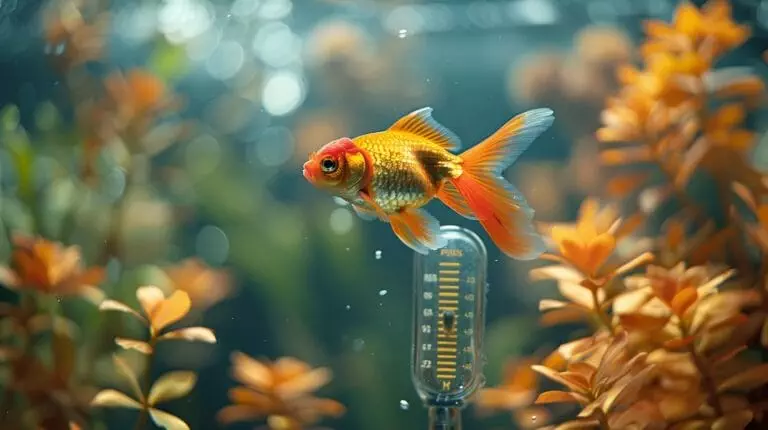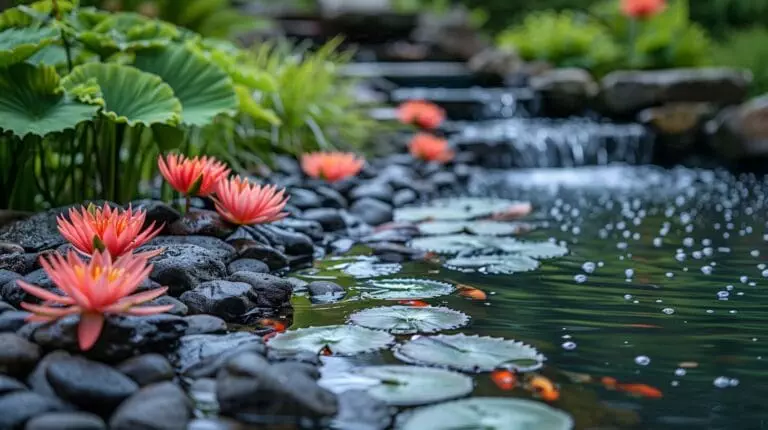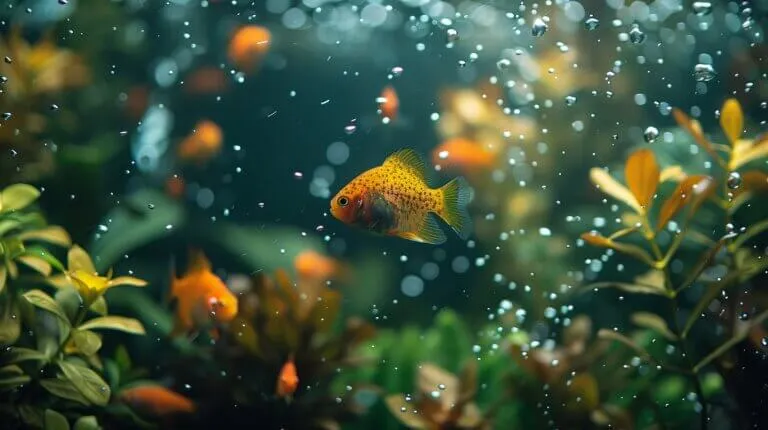Breeding betta fish can be tricky. Many aquarists struggle to get it right. But with the right steps, you can successfully breed these beautiful creatures. This guide will show you how to breed betta fish step-by-step. You’ll learn about tank setup, fish selection, and fry care.
I’ve spent years mastering the art of fishkeeping. Through trial and error, I’ve figured out what works best for breeding bettas. In this article, I’ll share my top tips to help you avoid common mistakes.
So how do you breed betta fish? Ready to start your betta breeding journey? Let’s begin.
Key Takeaways
- Set up a 40-cm tank with 18 liters of water between the range of 24°C to 27°C (75°F to 80°F) for breeding bettas.
- Feed bettas high-quality foods 4 times daily for 10 days before breeding.
- Male bettas build bubble nests and can fertilize up to 500 eggs at once.
- Remove the female after spawning and the male after fry start swimming freely.
- Feed betta fry infusoria at first, then brine shrimp and worms as they grow.
Setting Up the Ideal Breeding Tank for Betta Fish

Setting up a breeding tank for bettas, also known as Siamese fighting fish, is key to success. You’ll need the right size tank, plants, and hiding spots to create a safe space for your fish.
Selecting the Right Size and Conditions for a Betta Breeding Tank
Choose a 40-centimeter nano tank with an 18-liter capacity for breeding bettas. This size gives your fish enough space to swim and build bubble nests. 1 Fill the tank with a mix of cycled and aged water to create a healthy environment.
Keep the water temperature between the range of 24°C to 27°C (75°F to 80°F) using a nano heater. 2 This warmth helps bettas feel ready to breed.
Add catappa extract and Indian almond leaves to the tank. These natural items make the water slightly acidic, which bettas love. They also help prevent fungus on eggs. Place banana leaves or bubble wrap on the surface for the male to build his nest under.
A plastic tube can serve as a hiding spot for the female. These items create a safe, comfy space for your breeding pair.
A well-set breeding tank is the foundation of successful betta reproduction, says the expert at Uwphotoring.
Creating a Conducive Environment with Plants and Hiding Spots
Plants make a big difference in your betta breeding tank. Add java ferns and floating plants to create a natural feel. These plants give your bettas places to hide and rest. They also help keep the water clean.
Java ferns are great because they don’t need much care. Floating plants provide shade and make your fish feel safe. 2
Hiding spots are key for betta breeding success. Use ketpang leaves to make cozy spots for your fish. These leaves also help keep the water healthy. Place them around the tank edges.
Your bettas will love exploring and resting in these areas. A mix of plants and hiding spots creates the perfect home for breeding bettas. 3
Tank Maintenance and Water Quality Management
After setting up a cozy home for your bettas, you need to keep it clean. Good water quality is key for healthy fish. Here’s how to maintain your betta breeding tank:
- Change 10% of the water every week. Use treated water to refill the tank. 5
- Keep the water temp between the range of 24°C to 27°C (75°F to 80°F). Use a heater if needed.
- Add salt and anti-chlorine to new water. This helps your fish stay healthy.
- Clean the tank walls and decor. Use a soft sponge to remove algae.
- Check the filter often. Clean or replace it as needed.
- Test the water weekly. Look at pH, ammonia, nitrite, and nitrate levels.
- Remove uneaten food and waste daily. This keeps the water clean.
- Trim plants if they grow too much. Overgrown plants can mess up water quality.
- Keep the water level at 3 to 4 inches. Top off with treated water as it evaporates.
- Set up the breeding tank 10 days before you add fish. This lets good bacteria grow.
Understanding Betta Breeding Behavior and Pre-Spawn Preparation

Betta breeding starts with knowing your fish. You’ll need to spot signs that your bettas are ready to mate.
Recognizing Signs of Readiness in Male and Female Bettas
Male bettas show off their readiness with bright colors and flared fins. They build bubble nests at the water’s surface, a clear sign they’re ready to breed. Female bettas display vertical stripes on their bodies when they’re fertile. These stripes, called “breeding bars,” appear darker than their normal color.
A single pair can produce up to 500 eggs at a time. 4
Look for these key signs in your fish. The male will swim in a zigzag pattern and flare his gills at the female. She’ll respond by curving her body and pointing her head down. These behaviors mean your bettas are ready to spawn.
Make sure your breeding tank is set up before you put them together. 2
Conditioning Bettas for Breeding
Betta fish need proper conditioning before breeding. You must prepare them for about 10 days to ensure success.
- Feed high-quality foods 4 times daily
- Offer a protein-rich diet with varied options
- Include live or frozen foods like bloodworms and brine shrimp
- Keep males and females in separate tanks during conditioning
- Maintain clean water with regular changes
- Gradually increase water temperature to 80°F
- Provide hiding spots with plants or decorations
- Show males a mirror for 5 minutes daily to boost fitness
- Check for signs of health and vitality in both fish
- Ensure females develop egg-heavy bellies and vertical stripes 2
Introducing the Female Betta to the Breeding Tank
Introducing a female betta to the breeding tank requires care and timing. Follow these steps to ensure a successful introduction:
- Set up the tank: Place a clear container with the female inside the breeding tank.
- Acclimate the male: Let the male betta adjust to the tank for 24 hours.
- Watch for signs: Look for the male building a bubble nest and flaring at the female.2
- Check female readiness: Ensure the female shows vertical stripes and an egg spot.
- Release the female: Gently let her out of the container into the main tank.
- Monitor behavior: Keep an eye on both fish for signs of stress or aggression.
- Provide hiding spots: Add plants or decorations for the female to retreat if needed.
- Observe courtship: Watch for the male chasing and wrapping around the female.
- Be ready to separate: Have a net handy in case you need to remove either fish quickly from the breeding setup.
- Maintain water quality: Check parameters and do small water changes as needed.
The Breeding Process of Betta Fish

The breeding process of betta fish is a fascinating dance of nature. Male bettas build bubble nests, court females, and fertilize eggs. Want to learn more about this amazing process? Keep reading! If you’re considering breeding bettas, it’s important to understand their natural behaviors and needs. While it can be a beautiful and rewarding experience, it’s also important to ensure the health and safety of the fish involved. Additionally, it’s essential to research the compatibility of bettas with other fish species; for example, can a pleco live with a betta? This will help ensure a successful breeding process and a harmonious aquatic environment for all your fish.
The Courtship Ritual and Bubble Nest Construction
Male bettas start their courtship by flashing bright colors and spreading their fins. This display aims to catch the female’s eye. Next, the male builds a bubble nest at the water’s surface.
He uses his saliva to create tiny bubbles that stick together. This nest serves as a safe spot for eggs. 6
The mating process can last several hours. During this time, the male and female lock fins. They twist and turn in a dance-like motion. The female releases eggs, which the male catches and places in the bubble nest. He guards the nest fiercely, ensuring the eggs stay safe until they hatch. 7
Spawning and Fertilization of Eggs
After the bubble nest is ready, spawning begins. The male wraps his body around the female. He squeezes her to release eggs. As eggs drop, he catches them in his mouth. He then spits them into the bubble nest. 2
This process repeats many times. The male fertilizes the eggs as he catches them. He places up to 500 eggs in the nest. The eggs stick to air bubbles for safety. You’ll need to remove the female soon after. This prevents her from eating the eggs or getting hurt by the male.
Post-Spawn Care: Removing the Female and Caring for the Male
The spawning process is complete. Now, it’s time to focus on post-spawn care.
- Take out the female betta right away. She’s done her job and needs to rest.
- Keep the male in the tank. He’ll guard the eggs and fry.
- Watch the male closely. He’ll fan the eggs and catch any that fall.
- Don’t feed the male for now. He’s busy with the eggs.
- Keep the water clean. Do small water changes daily.
- Lower the water level. This helps the male care for the eggs.
- Use a sponge filter. It’s gentle on the eggs and future fry.
- Add an Indian almond leaf. It helps prevent fungus.
- Remove the male when the fry start swimming freely. His job is done.
- Put the air stone back in. It helps the fry grow strong.
Caring for Betta Fry Post-Hatch

After the eggs hatch, you’ll need to care for the tiny betta fry. These newborns need special food and clean water to grow strong and healthy.
The First Hours: Egg Hatching and Fry Development
Betta fry hatch about 36 hours after eggs are laid. These tiny fish need special care in their first hours of life.
- Fry hatch from eggs stuck to the bubble nest
- Newly hatched fry can’t swim and hang from the nest
- Male betta guards the nest and catches falling fry.
- Fry feed on their yolk sacs for the first 24 hours
- After 24 hours, fry start to swim freely 2
- Remove the male once all fry are free-swimming
- Keep water clean and warm at 80°F
- Start feeding infusoria when fry swim horizontally
- Feed small amounts 4 to 6 times daily
- Do daily water changes of 10% to 20%
- Watch for fry growth and development
- Fry grow quickly in first weeks with good care
Feeding and Nutrition for Growing Betta Fry
As your betta fry grow, their nutritional needs change. You’ll need to adjust their diet to support healthy development.
- Fry rely on egg sacs for 2 to 3 days after hatching 8
- Introduce infusoria as first food when fry start swimming
- Feed baby brine shrimp and microworms at 3 to 4 days old
- Offer 4 to 6 small meals daily to prevent overfeeding
- Use powdered fry food for easy digestion
- Add black worms and grindel worms at 3 to 4 weeks
- Gradually increase food size as fry grow
- Maintain clean water with frequent changes
- Remove uneaten food to keep tank clean
- Supplement with high-quality flakes at 6 to 8 weeks
- Monitor fry growth and adjust feeding as needed
Managing Water Quality and Fry Safety
Betta fry need clean water to grow strong. You must keep their tank in top shape. Here’s how to manage water quality and keep your fry safe:
- Change water often. Do small 20% to 25% water changes weekly. This removes waste and keeps water fresh. 9
- Watch ammonia levels. Test water daily with a kit. Keep ammonia at zero for healthy fry.
- Maintain proper temperature. Keep water between 75°F to 80°F. Use a heater if needed. 2
- Filter gently. Use a sponge filter. It won’t suck up tiny fry.
- Feed carefully. Don’t overfeed. Remove uneaten food after 5 minutes.
- Add live plants. They help clean water and give fry places to hide.
- Keep tank covered. Use a tight lid to prevent fry from jumping out.
- Separate aggressive fry. Move bullies to their own tank if needed.
- Clean the bottom. Siphon waste from the tank floor during water changes.
- Avoid sudden changes. Adjust water slowly when doing maintenance.
Long-Term Care and Breeding Cycle Management for Bettas

When you’re managing the long-term care of your bettas, it’s essential to plan for fry growth and their tank changes. You’ll also need to keep a close eye on their health to prevent any diseases that could affect their development.
Additionally, understanding breeding cycle timelines and allowing proper rest periods for adult bettas will help guarantee a healthy breeding process.
Planning for Fry Growth and Tank Transitions
Shifting betta fry to larger tanks is an important step in guaranteeing their healthy growth and development. As your fry can swim and start exploring, it’s essential to plan their changeover carefully.
Timing is significant, so consider transferring them when they’re about 4 to 6 weeks old and have reached a size where they can thrive in a larger tank.
To make this process smoother and avoid common pitfalls, keep these points in mind:
- Gradual acclimation: Introduce fry to the new tank gradually to reduce stress.
- Water quality: Verify the new tank has ideal water conditions to support healthy growth.
- Space and hiding spots: Provide plenty of swimming space and hiding spots to help them feel secure.
- Monitor feeding: Adjust feeding routines according to the fry’s growth and activity levels.
Health Monitoring and Disease Prevention in Betta Fry
Monitoring the health of your betta fry is crucial for their long-term development and overall well-being. By staying vigilant, you can guarantee they thrive and become vibrant adult fish.
Start by observing your fry daily for signs of health issues, such as unusual swimming patterns, lack of appetite, or discoloration. These can indicate stress or disease.
Common diseases in betta fry include fin rot and ich. To prevent and treat these conditions, maintain a clean tank and monitor water quality closely. Regular water changes and proper filtration are critical. If you notice any fry showing symptoms, isolate them immediately to prevent the spread of illness.
You’ll also want to keep an eye on their diet. Feed your betta fry high-quality food, like micro-worms or specially formulated fry food, to promote healthy growth. Overfeeding can lead to water quality issues, so be mindful of portion sizes.
Breeding Cycle Timelines and Rest Periods for Adult Bettas
After ensuring the health of your betta fry, it’s important to understand the breeding cycle of adult bettas to maintain their energy and improve your breeding success.
Adult bettas typically engage in a breeding cycle every two to three weeks. This frequency allows them to successfully breed while ensuring ideal health and longevity. However, between breeding attempts, you must provide adequate rest periods.
Consider these key points for managing your bettas:
- Rest Periods: Allow at least two weeks of rest between breeding cycles to help your fish recover.
- Environmental Stability: Maintain stable water conditions to reduce stress and promote healthy spawning.
- Dietary Needs: Feed your bettas a nutritious diet rich in proteins during the breeding cycle to enhance their energy levels.
- Monitoring Behavior: Keep an eye on their aggression and pair compatibility before each breeding attempt.
Conclusion
Breeding betta fish takes patience and care. You’ll need the right setup, food, and know-how. Watch for signs your fish are ready to mate. Give them a safe place to spawn and care for their young. This includes providing them with the proper water conditions and ensuring that they have enough space to build their bubble nest. Once the eggs are laid, it’s important to remove the female betta to prevent her from eating the eggs. Additionally, it’s crucial to monitor the water temperature and quality to ensure the young fry have the best chance of survival. In addition, if you have a mystery snail in the tank, it’s important to also provide proper mystery snail egg care to ensure the health of the snail offspring.
With time and practice, you can raise healthy betta fry. Your efforts will pay off with a new generation of these beautiful fish.
FAQs
1. How do I set up a tank for breeding bettas?
Use a 40 cm or 18 liters tank. Add hiding spots for the female. Keep the water level low. Put in a divider. Cover the tank to keep the air warm.
2. When is the best time to introduce male and female bettas?
Wait till the male builds a bubble nest. Then, place the female in her side. If they show interest, remove the divider. Watch them closely.
3. What should I do after the eggs are released?
Take the female out right away. Let the male care for the eggs. He’ll guard the nest. In about 3 days, tiny fry will hatch and start to swim.
4. How do I feed the baby fish?
Use quality betta food such as a special fry food. Feed them often, but not too much. Remove extra food that sinks. As they grow, give them bigger food bits.
5. When should I move the fry to a bigger tank?
Move them when they’re about 3 to 4 weeks old. Use a larger tank with more space. Add plants for hiding. Do water changes every few days.
6. How long does it take for betta fry to become adult fish?
It takes about 3 to 4 months for fry to look like adult bettas. They’ll get their full colors around 6 months. Keep feeding them good food as they grow.
References
- ^ https://www.youtube.com/watch?v=F_0tuFs5G5w
- ^ https://home.adelphi.edu/~ve21375/Betta%20Fish%20Care.html
- ^ https://en.wikipedia.org/wiki/Siamese_fighting_fish
- ^ https://wildbettablog.com/betta-fish-eggs/
- ^ https://www.aqueon.com/resources/care-guides/betta
- ^ https://a-z-animals.com/animals/siamese-fighting-fish/siamese-fighting-fish-facts/betta-fish-breeding-guide/
- ^ https://animaldiversity.org/accounts/Betta_splendens/
- ^ http://www.bettaterritory.nl/BT-BreedingRaisingfry.htm
- ^ https://www.aquaticlivefood.com.au/betta-fish-care-guide-tank-mates-size-breeding-and-more/





